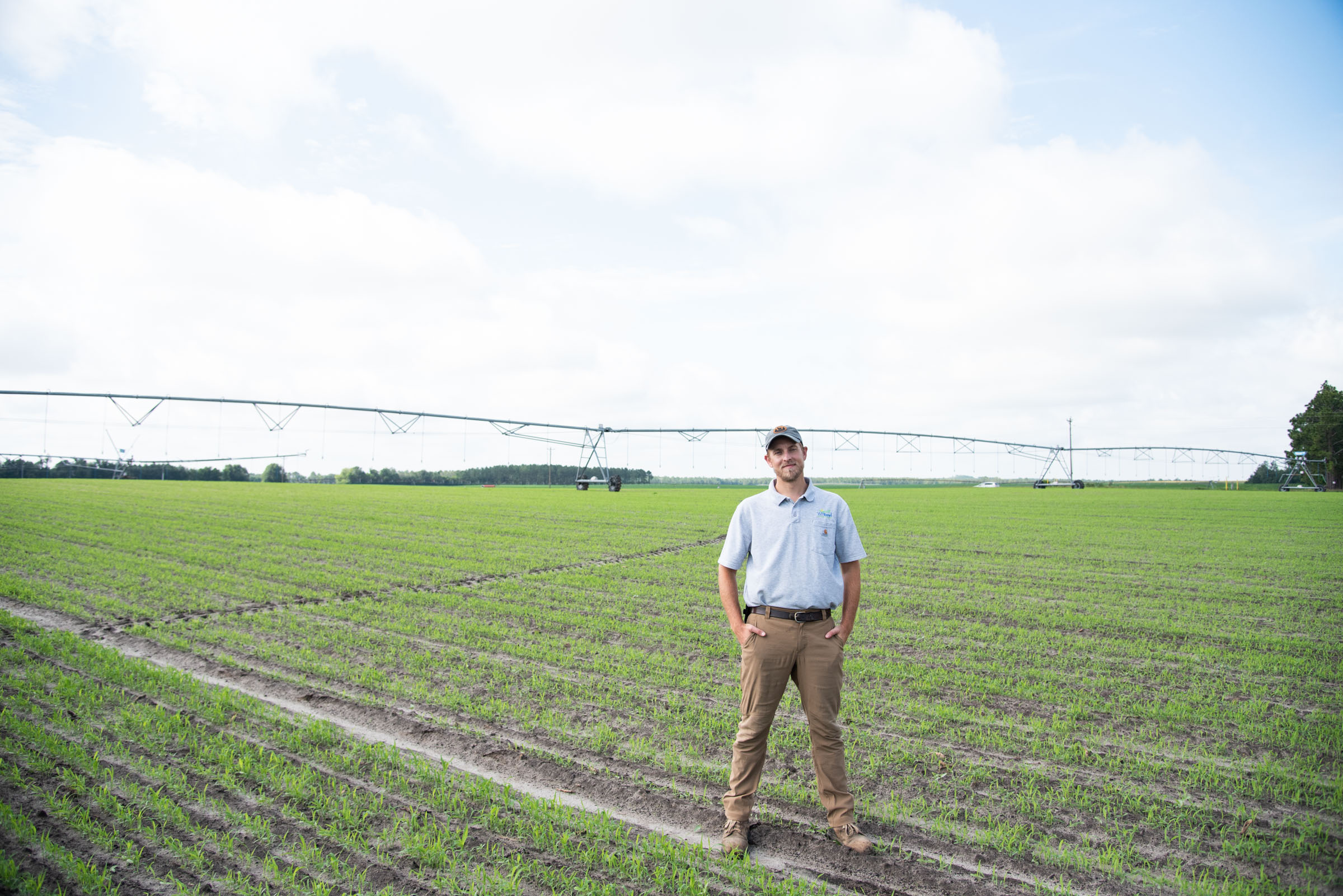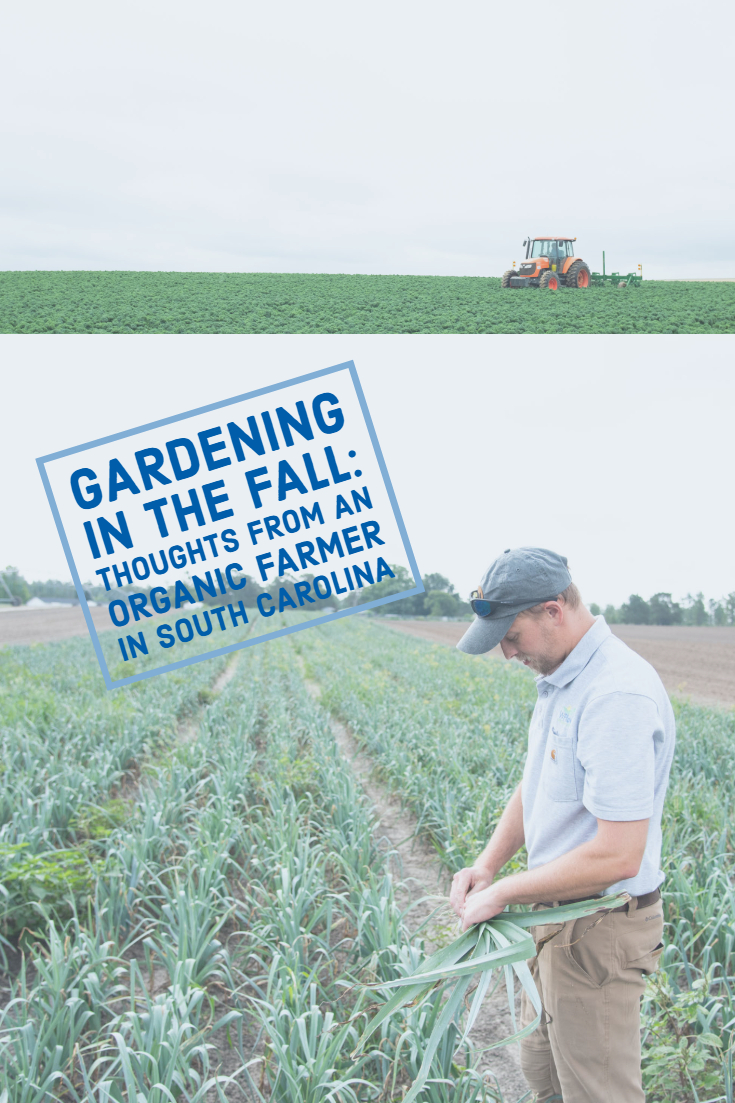by Mark Spicer, Assistant Organic Farm Manager
Based on our experience at WP Rawl, we believe large farmers and small gardeners alike are presented with an ideal growing environment during the fall here in the Midlands of South Carolina. When most growers in the country are starting to think about winding down and preparing for winter, we Southern growers can start thinking about all the bountiful homegrown meals we can make for our friends and family. Ultimately, that’s why we at WP Rawl do what we do. Knowing that our family, friends, and neighbors are choosing our product when they go to the grocery store makes all our hard work worthwhile.
First steps
So what can you do to turn your plot of land or corner in your backyard into a bountiful harvest? Well, first of all you’ll need to prepare the ground by turning the soil over with either a tiller or a shovel. The goal is to break up the large chunks of sod or dirt so that you’re left with a smooth, weed-free plot of ground. Turning the soil helps break up large clots of dirt, get rid of weeds, and creates a nice smooth seedbed ready for planting.
Next, you’ll want to take a look at your soil and think about how your vegetables will get the nutrients they need to grow. If you have sandy soil, you’ll need to fertilize and water your plants more often since sandy soils don’t hold nutrients or moisture well. If the soil is harder to break up and sticks together in clumps, then you’ll have to work a little harder to prepare your plot, but it also means that most likely you have better conditions to grow vegetables.
Compost
Compost is the greatest material asset we have to improve our soils here on the organic farm at Rawl. After just three years of mixing compost into our soil before planting, we have seen a massive increase in productivity and plant health. In my opinion, adding as much well-made compost to your garden as possible is the best thing you can do for the crops you plan to grow. There are local companies that sell or give away compost, and it is also sold in 1 to 3.8 cubic foot bags at most large hardware stores. The minimum I would suggest to add is 3” of compost on top of your garden. There are many gardening sites that do calculations for you, but an example would be: 2 cubic feet of compost covers an 8 foot by 8 foot garden plot with 3 inches of compost.
Fall Veggies
Now we get to the fun part: planting! Here in the Midlands, we have few limitations as to what can grow well in the fall. If your plot is ready mid-July to early August, you’ll have the largest selection of vegetables to choose from. We at WP Rawl primarily grow “leafy greens”: kale, collards, and mustard greens, along with cilantro, parsley, green onions, and leeks. They are incredibly popular, especially during the holidays, and this time of year is well suited for their growth. Along with leafy greens, lettuces, broccoli, cauliflower, spinach, beets, carrots, turnips, and radishes are perfect candidates for fall gardening; they all thrive in cool weather and even improve in flavor with a little frost. It’s even possible for backyard gardeners in this area to start late-season tomatoes in July and August if they’re ambitious. They require more care and knowledge than most vegetables, but there isn’t anything quite like eating a homegrown tomato fresh off the vine.
Checking recently planted seeds.
Root vegetables, such as beets and carrots, should be started from seed in relatively weed-free soil any time from August 1st to mid-September. Spinach and lettuce can also be grown easily from seed, but planting them as transplants will also work. Vegetable transplants are generally 4 to 6-week-old plants grown in multi-cell trays or small pots started in a climate-controlled greenhouse. Most nurseries and hardware stores will probably be running sales on their transplants in the fall because they don’t want to keep these plants through the winter. Leafy greens (kale, collards, mustard greens, etc.) will grow better if you plant them as transplants.
Making It Grow
After you’ve prepared your soil, spread your compost, and planted your seeds and transplants, the most important thing you’ll want to do is keep the soil moist and weed-free. Hoeing or pulling weeds once or twice a week is ideal, and also a great family activity that gets everyone outside and involved with the bounty to come. Watering twice per day while it’s still hot should be enough to get your seeds to pop up and your transplants to take root. You want to keep the ground moist, but not so wet that you leave puddles. As your garden matures and fall really sets in, cooler weather and more frequent rain means you won’t have to water as much.
If you see that your plants are slowing down in their growth, a tablespoon of organic garden fertilizer per plant is plenty to get them going again. If you’d like to fertilize your entire garden on a regular basis to ensure consistent growth, you have a couple options. The first: add about an inch of compost to your garden every 2 to 3 weeks; rake it into the soil around the plants gently and be careful not to get it on the leaves of the plant because the concentrated nutrient levels may burn the pllant if it sticks. The second option: every 2 to 3 weeks sprinkle your organic fertilizer of choice at the suggested amount (there are many options at the hardware store or nursery to choose from, but a standard organic vegetable garden fertilizer will work just fine).
Depending on what you grow and the conditions of your soil, you should be able to start harvesting the spinach and leafy greens after about 30 to 40 days. Picking individual leaves, instead of cutting down the whole plant, will allow you to harvest for several months or until a hard freeze sets in. For the root vegetables, radishes will be ready in 20 to 30 days, about 45 days for baby beets and carrots, and 60 to 70 days for them to fully mature.
Summer/Fall Leek.
It is a big responsibility to care for a garden, but it doesn’t need to be seen as a hardship. I've discovered that all work is better and usually more enjoyable when shared with others. Everything from land preparation to planting to watering to pulling weeds offers the whole family an opportunity to get involved in an incredibly rewarding outdoors activity. Some of the best experiences I had as a child came from helping my mom cut lettuce for that night’s dinner. Here in the Midlands, nature has given us the gift of beautiful and often bountiful fall seasons. I would encourage families and individuals alike, to try a fall garden in the South at least once. I sincerely believe you’ll be amazed at what a little hard work and commitment can produce. I encourage anyone with questions about gardening, or wanting to share their experience, to please reach out to me (mark.spicer@rawl.net). I would love to hear from you!
Happy growing!
-- Mark
PS: Are you growing a fall garden and posting about it on social media? Tag us in your photos so we can cheer you on! @WPRawl and @naturesgreens



